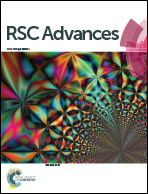Ag2S quantum dots in situ coupled to hexagonal SnS2 with enhanced photocatalytic activity for MO and Cr(vi) removal†
Abstract
A novel visible-light-driven Ag2S/SnS2 composite photocatalyst was successfully fabricated via a simple in situ hydrothermal-ion-exchange method. The materials were systematically characterized by various techniques. XRD, XPS, and TEM analysis demonstrated the successful formation of Ag2S quantum dots on the surface of SnS2 nanoplates. The Ag2S/SnS2 composite materials exhibited increased photocatalytic activity compared to pure SnS2 for the removal of methyl orange (MO) and Cr(VI), and the 1% Ag2S/SnS2 composite material showed the best activity under visible light irradiation. Holes (h+) and superoxide radicals (˙O2−) were the major active species during the photocatalytic process. The in situ formation of Ag2S quantum dots provided an effective way to facilitate carrier transfer and separation, which is believed to be responsible for the enhanced photocatalytic performance.



 Please wait while we load your content...
Please wait while we load your content...